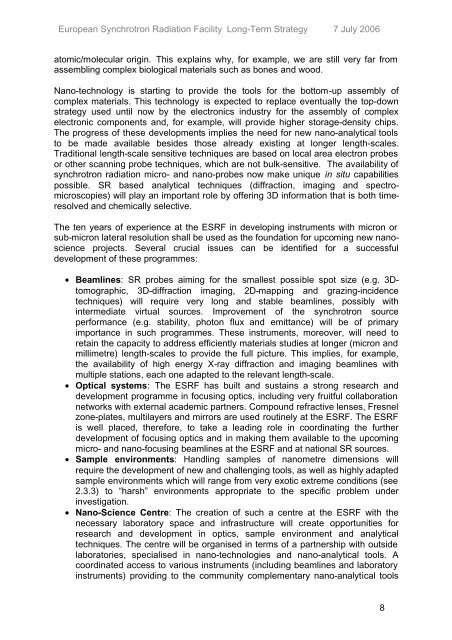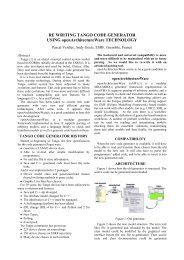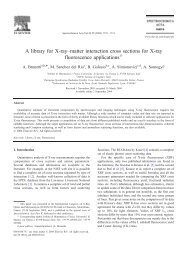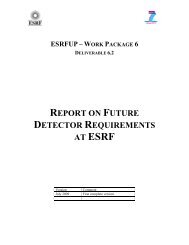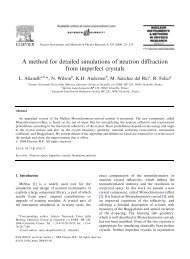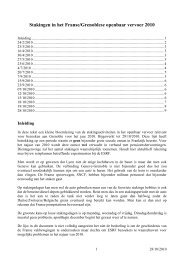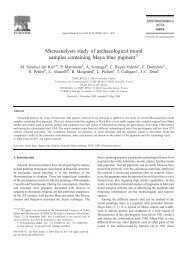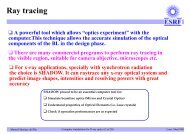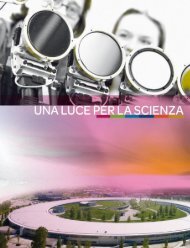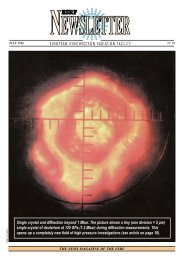New Scientific Opportunities at the European Synchrotron Radiation ...
New Scientific Opportunities at the European Synchrotron Radiation ...
New Scientific Opportunities at the European Synchrotron Radiation ...
Create successful ePaper yourself
Turn your PDF publications into a flip-book with our unique Google optimized e-Paper software.
<strong>European</strong> <strong>Synchrotron</strong> Radi<strong>at</strong>ion Facility Long-Term Str<strong>at</strong>egy 7 July 2006<br />
<strong>at</strong>omic/molecular origin. This explains why, for example, we are still very far from<br />
assembling complex biological m<strong>at</strong>erials such as bones and wood.<br />
Nano-technology is starting to provide <strong>the</strong> tools for <strong>the</strong> bottom-up assembly of<br />
complex m<strong>at</strong>erials. This technology is expected to replace eventually <strong>the</strong> top-down<br />
str<strong>at</strong>egy used until now by <strong>the</strong> electronics industry for <strong>the</strong> assembly of complex<br />
electronic components and, for example, will provide higher storage-density chips.<br />
The progress of <strong>the</strong>se developments implies <strong>the</strong> need for new nano-analytical tools<br />
to be made available besides those already existing <strong>at</strong> longer length-scales.<br />
Traditional length-scale sensitive techniques are based on local area electron probes<br />
or o<strong>the</strong>r scanning probe techniques, which are not bulk-sensitive. The availability of<br />
synchrotron radi<strong>at</strong>ion micro- and nano-probes now make unique in situ capabilities<br />
possible. SR based analytical techniques (diffraction, imaging and spectromicroscopies)<br />
will play an important role by offering 3D inform<strong>at</strong>ion th<strong>at</strong> is both timeresolved<br />
and chemically selective.<br />
The ten years of experience <strong>at</strong> <strong>the</strong> ESRF in developing instruments with micron or<br />
sub-micron l<strong>at</strong>eral resolution shall be used as <strong>the</strong> found<strong>at</strong>ion for upcoming new nanoscience<br />
projects. Several crucial issues can be identified for a successful<br />
development of <strong>the</strong>se programmes:<br />
• Beamlines: SR probes aiming for <strong>the</strong> smallest possible spot size (e.g. 3Dtomographic,<br />
3D-diffraction imaging, 2D-mapping and grazing-incidence<br />
techniques) will require very long and stable beamlines, possibly with<br />
intermedi<strong>at</strong>e virtual sources. Improvement of <strong>the</strong> synchrotron source<br />
performance (e.g. stability, photon flux and emittance) will be of primary<br />
importance in such programmes. These instruments, moreover, will need to<br />
retain <strong>the</strong> capacity to address efficiently m<strong>at</strong>erials studies <strong>at</strong> longer (micron and<br />
millimetre) length-scales to provide <strong>the</strong> full picture. This implies, for example,<br />
<strong>the</strong> availability of high energy X-ray diffraction and imaging beamlines with<br />
multiple st<strong>at</strong>ions, each one adapted to <strong>the</strong> relevant length-scale.<br />
• Optical systems: The ESRF has built and sustains a strong research and<br />
development programme in focusing optics, including very fruitful collabor<strong>at</strong>ion<br />
networks with external academic partners. Compound refractive lenses, Fresnel<br />
zone-pl<strong>at</strong>es, multilayers and mirrors are used routinely <strong>at</strong> <strong>the</strong> ESRF. The ESRF<br />
is well placed, <strong>the</strong>refore, to take a leading role in coordin<strong>at</strong>ing <strong>the</strong> fur<strong>the</strong>r<br />
development of focusing optics and in making <strong>the</strong>m available to <strong>the</strong> upcoming<br />
micro- and nano-focusing beamlines <strong>at</strong> <strong>the</strong> ESRF and <strong>at</strong> n<strong>at</strong>ional SR sources.<br />
• Sample environments: Handling samples of nanometre dimensions will<br />
require <strong>the</strong> development of new and challenging tools, as well as highly adapted<br />
sample environments which will range from very exotic extreme conditions (see<br />
2.3.3) to “harsh” environments appropri<strong>at</strong>e to <strong>the</strong> specific problem under<br />
investig<strong>at</strong>ion.<br />
• Nano-Science Centre: The cre<strong>at</strong>ion of such a centre <strong>at</strong> <strong>the</strong> ESRF with <strong>the</strong><br />
necessary labor<strong>at</strong>ory space and infrastructure will cre<strong>at</strong>e opportunities for<br />
research and development in optics, sample environment and analytical<br />
techniques. The centre will be organised in terms of a partnership with outside<br />
labor<strong>at</strong>ories, specialised in nano-technologies and nano-analytical tools. A<br />
coordin<strong>at</strong>ed access to various instruments (including beamlines and labor<strong>at</strong>ory<br />
instruments) providing to <strong>the</strong> community complementary nano-analytical tools<br />
8


